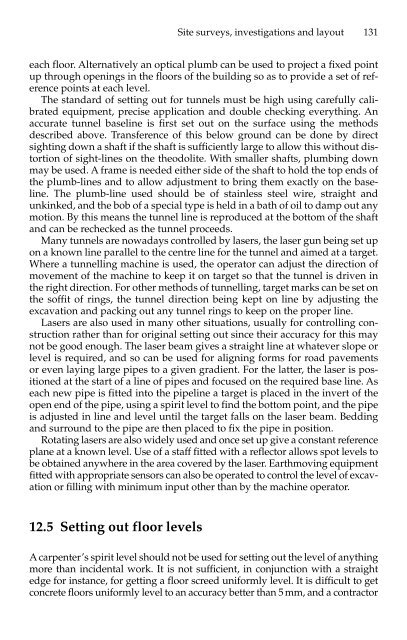Civil Engineering Project Management (4th Edition)
Create successful ePaper yourself
Turn your PDF publications into a flip-book with our unique Google optimized e-Paper software.
each floor. Alternatively an optical plumb can be used to project a fixed point<br />
up through openings in the floors of the building so as to provide a set of reference<br />
points at each level.<br />
The standard of setting out for tunnels must be high using carefully calibrated<br />
equipment, precise application and double checking everything. An<br />
accurate tunnel baseline is first set out on the surface using the methods<br />
described above. Transference of this below ground can be done by direct<br />
sighting down a shaft if the shaft is sufficiently large to allow this without distortion<br />
of sight-lines on the theodolite. With smaller shafts, plumbing down<br />
may be used. A frame is needed either side of the shaft to hold the top ends of<br />
the plumb-lines and to allow adjustment to bring them exactly on the baseline.<br />
The plumb-line used should be of stainless steel wire, straight and<br />
unkinked, and the bob of a special type is held in a bath of oil to damp out any<br />
motion. By this means the tunnel line is reproduced at the bottom of the shaft<br />
and can be rechecked as the tunnel proceeds.<br />
Many tunnels are nowadays controlled by lasers, the laser gun being set up<br />
on a known line parallel to the centre line for the tunnel and aimed at a target.<br />
Where a tunnelling machine is used, the operator can adjust the direction of<br />
movement of the machine to keep it on target so that the tunnel is driven in<br />
the right direction. For other methods of tunnelling, target marks can be set on<br />
the soffit of rings, the tunnel direction being kept on line by adjusting the<br />
excavation and packing out any tunnel rings to keep on the proper line.<br />
Lasers are also used in many other situations, usually for controlling construction<br />
rather than for original setting out since their accuracy for this may<br />
not be good enough. The laser beam gives a straight line at whatever slope or<br />
level is required, and so can be used for aligning forms for road pavements<br />
or even laying large pipes to a given gradient. For the latter, the laser is positioned<br />
at the start of a line of pipes and focused on the required base line. As<br />
each new pipe is fitted into the pipeline a target is placed in the invert of the<br />
open end of the pipe, using a spirit level to find the bottom point, and the pipe<br />
is adjusted in line and level until the target falls on the laser beam. Bedding<br />
and surround to the pipe are then placed to fix the pipe in position.<br />
Rotating lasers are also widely used and once set up give a constant reference<br />
plane at a known level. Use of a staff fitted with a reflector allows spot levels to<br />
be obtained anywhere in the area covered by the laser. Earthmoving equipment<br />
fitted with appropriate sensors can also be operated to control the level of excavation<br />
or filling with minimum input other than by the machine operator.<br />
12.5 Setting out floor levels<br />
Site surveys, investigations and layout 131<br />
A carpenter’s spirit level should not be used for setting out the level of anything<br />
more than incidental work. It is not sufficient, in conjunction with a straight<br />
edge for instance, for getting a floor screed uniformly level. It is difficult to get<br />
concrete floors uniformly level to an accuracy better than 5 mm, and a contractor


















